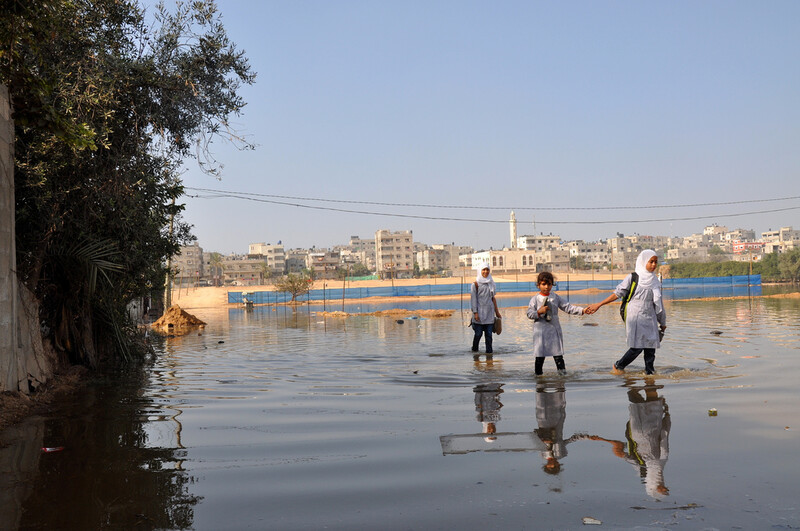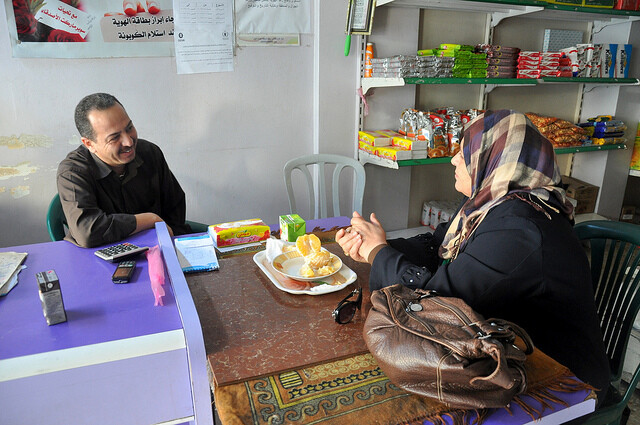Rights and Accountability 21 November 2013

Girls walk to school in sewage-flooded streets of Gaza City.
OxfamOne year ago, a ceasefire agreement between Israel and Hamas ended an eight-day Israeli bombardment that killed 174 Palestinians, the vast majority civilians, dozens of them children.
Israel even carried out deliberate killings of journalists, offering justifications that Human Rights Watch termed “evidence of war crimes.”
Six Israelis, four of them civilians, also died as a result of Palestinian fire.
“Quiet” for some
The past year has been “the quietest period in ten years, with the lowest numbers of rocket attacks from Gaza and of Palestinian casualties from Israeli incursions into Gaza,” according to an update from the UK development agency Oxfam.
But while Israelis are enjoying unprecedented “quiet,” the term “ceasefire” is a complete misnomer for Palestinians in Gaza, where the humanitarian situation is also worse than ever.

“Life is worse than a year ago” says Gaza shopkeeper Ibrahim Zayed.
Oxfam“Life is worse than a year ago. We just want to make a living but it’s now almost impossible. The electricity is off most of the day, and the fuel is so expensive I can only afford to turn the generator on for 30 minutes at a time,” Ibrahim Zayed, a shopkeeper in northern Gaza, told Oxfam.
Zayed has seen the number of customers in his shop drop by half and fears he will have to close.
“The crisis affects every part of our lives – last week my daughter had a chest problem and needed an examination,” Zayed said.
“I drove around looking for an open health center, but everywhere was closed because they had no power. We had to drive all the way into Gaza City to find one open.”
Gaza becoming “uninhabitable”
UNRWA, the UN agency for Palestine refugees, said this week that 19 of its 20 construction projects in Gaza had ground to a halt because Israel has refused to allow building materials into the territory.
With the tightened Israeli blockade and Egypt’s systematic destruction of tunnels under its border since the July military coup, “Gaza is quickly becoming uninhabitable,” outgoing UNRWA Commissioner Genera Filippo Grandi warned this week.
The tunnels have been a lifeline providing Palestinians a way to evade the Israeli siege and bring in food, basic goods, fuel and construction supplies.
“Further conflict is bound, as before, to affect civilians in Gaza and southern Israel, unless its causes are addressed,” Grandi said.
Frequent “ceasefire” violations
As Oxfam notes:
the ceasefire has been violated on numerous occasions. In the past year, Israel has carried out 19 airstrikes and over 300 incidents of border and naval fire, causing seven fatalities and at least 132 injuries. Palestinian factions have fired over 140 homemade rockets towards Israel, with no casualties reported.
For some civilians, security has worsened. So far in 2013, there have been over 150 incidents of Israeli naval fire against Gaza fishermen – a 40 percent increase over the past two years.
These numbers underscore the fact that while violence is overwhelmingly perpetrated by Israelis against Palestinians, media coverage of Gaza tends to focus disproportionately on armed action by Palestinians, even though this year it has resulted in no injuries.
Economy devastated
Instead of lifting its blockade and allowing reconstruction, Israel’s tight siege continues to devastate the lives of Palestinians in Gaza where, Oxfam says, “80 percent of people … receive international aid, 57 percent of households are food insecure, exports are virtually non-existent, many basic services are barely functioning, and unemployment is over 35 percent and rising.”
Such poverty and dependency can only be the result given that “entrance of goods into Gaza via Kerem Shalom, the sole Israeli-controlled crossing, stands at around 50 percent of pre-blockade levels,” according to Oxfam.
While Israel often claims – without evidence – that its restrictions on imports are designed to prevent Palestinians obtaining goods that could have a use in military resistance, what possible explanation could it give for banning exports?
Through October 2013, Israel had only allowed 111 trucks of exports out of Gaza, less than half the figure for 2011 and 2012.
This compares with almost 6,000 trucks in 2007 and puts 2013 on course to be the worst year for exports from Gaza since 2009.
The only effect of Israel banning exports is to damage – as effectively as if it were using bombs – any self-sufficiency in Gaza and to further immiserate the population.
Following Egypt’s crackdown on the tunnels, the true impact of Israel’s siege has been revealed: with fuel in short supply, much of Gaza has no power for 12-18 hours per day, forcing children to study in the dark.
And as the sewage pumps have ceased functioning, children in many areas wade to school through sewage.
Isolating the people
Israel and Egypt have together ensured unprecedented isolation of the almost 1.7 million Palestinians in Gaza.
Fewer than 6,000 people are currently able to use the Erez crossing with Israel every month to reach the occupied West Bank, hospitals in present-day Israel or to travel abroad with difficult-to-obtain permits.
This compares with over half a million monthly crossings through Erez in the year 2000, Oxfam says.
Since Israel has sought to close Gaza off, Egypt’s Rafah border crossing has become the only exit to the outside world for most of its residents.
Already plagued by chronic closures from the Egyptian side, since the July coup the numbers passing through Rafah have dropped from 20,000 per month to fewer than 4,000.
Lift the blockade
Faced with the dire situation in Gaza one year after the “ceasefire,” UNRWA’s Grandi renewed calls for lifting the blockade:
Perhaps strengthening the human security of the people of Gaza is a better avenue to ensuring regional stability than physical closures, political isolation and military action. To obtain this, first and foremost, the Israeli blockade – which is illegal – must be lifted. Meanwhile, the United Nations must be allowed to at least continue construction projects and provide a few extra jobs to the beleaguered population.
Yet even these limited aspirations seem unlikely to be fulfilled as Israel’s punishing siege has become the “new normal” tolerated by the so-called international community.
The irony of the last year is that Palestinians are constantly lectured: “It is your resistance that brings Israeli punishment on you. Be quiet and you will see things improve.”
Yet the fact that Israelis have enjoyed unprecedented quiet, while Palestinians in Gaza are in a worse situation than ever, demonstrates that this is, and has always been, a lie.
It is Israeli impunity, not Palestinian resistance, that allows the catastrophe in Gaza to continue.





Comments
REPORTS OF A RANGE OF ZIONIST CRIMES ARE KEPT FROM PUBLIC...
Permalink Peter Loeb replied on
This is an excellent contribution. The breadth of evils of israel and the range of
their effects is out there. It is a well-kep secret from the (western) public. Two
sources are suggested:
1. "REPORT OF THE COMMITTEE ON THE EXERCISE OF THE INALIENABLE
RIGHTS OF THE PALESTINIAN PEOPLE", General Assembly Official Records
(= "document"), Sixty-eighth Session, Supplemental No. 35 (of Oct. 7, 2013)
To obtain complete document go to United Nations General Assembly, Documents,
enter A/68/35 (search). [My opinion is that there are flaws but it is an excellent
source nonetheless.]
2. Lawrence Davidson's CULTURAL GENOCIDE (2013)